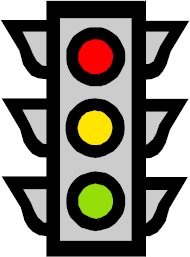 In February 2006, the City of Gallatin unveiled the Automated Camera Enforcement System. The system, known as A.C.E.S., is designed to catch drivers running red lights at intersections. Rather than relying on police officers to perform this function, the cameras automatically trigger when a driver enters an intersection after the light turns red. A police officer then reviews the tape, prints off a citation, and mails it to the owner of the vehicle that ran the light.
In February 2006, the City of Gallatin unveiled the Automated Camera Enforcement System. The system, known as A.C.E.S., is designed to catch drivers running red lights at intersections. Rather than relying on police officers to perform this function, the cameras automatically trigger when a driver enters an intersection after the light turns red. A police officer then reviews the tape, prints off a citation, and mails it to the owner of the vehicle that ran the light.
According to the Insurance Institute for Highway Safety, Gallatin is not alone. At least nine other communities in Tennessee, including Knoxville, Chattanooga, Germantown, Murfreesboro, and Jackson currently operate these devices.1 Other Tennessee communities considering their use include Clarksville, Morristown, Cookeville, La Follette, and Oak Ridge. Additionally, Chattanooga, Jackson, Mount Carmel, Red Bank, and Selmer have begun using speed cameras, similar devices used to capture speeding motorists.2
Four companies provide most of the red light camera systems used in Tennessee. Arizona-based American Traffic Solutions installed the systems in Gallatin, Jackson, and Red Bank.3 Another company based in California, Redflex Traffic Systems, contracted with Kingsport, Knoxville, and Mount Carmel to provide similar services.4 Murfreesboro uses TraffiPax, a subsidiary of a German company.5 Germantown has the longest-running system, put in place in 2002 by Rhode Island-based Nestor Traffic Systems.6
What is a Red Light Camera System?
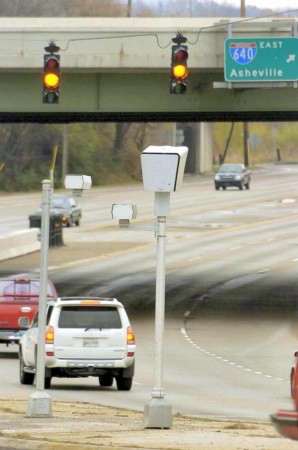 Red Light Cameras are sophisticated surveillance systems designed to catch drivers who run red lights. Though the majority of the systems in Tennessee focus on red light runners, some police speed limits, while others do both. They work through a complex system of triggers, cameras and computers.7
Red Light Cameras are sophisticated surveillance systems designed to catch drivers who run red lights. Though the majority of the systems in Tennessee focus on red light runners, some police speed limits, while others do both. They work through a complex system of triggers, cameras and computers.7
Drivers “caught” typically receive a citation by mail within a few weeks of the incident. These citations are a cash cow for municipalities. In 2007, the City of Gallatin issued almost 20,000 citations, a number equal to more than half the town’s population.8 The City collected nearly $1 million in fines attributable to the cameras, not including court costs associated with defendants who chose to appear in court and contest their fines. According to the citations, defendants must pay the fine. The only other option is to assign liability to another party by submitting an affidavit stating that the defendant was not driving the vehicle at the time.9
The Stated Justification
Red light camera systems attract the attention of communities looking to reduce their operating expenses. In theory, the systems reduce the number of paid officers on duty, thereby decreasing overhead expenses. Additionally, the devices work 24 hours a day, seven days a week, with little or no maintenance. A single officer typically reviews the film footage before citations are sent.
Communities implementing these systems primarily cite safety as the reason to install the cameras. According to these cities, the cameras will punish those who create dangerous conditions by running red lights, encouraging them to act more cautiously in the future. Further, the known existence of the cameras is said to encourage drivers to begin braking when the light turns yellow, rather than increasing their speed to “beat the light.”
Follow the Money: The Real Reason
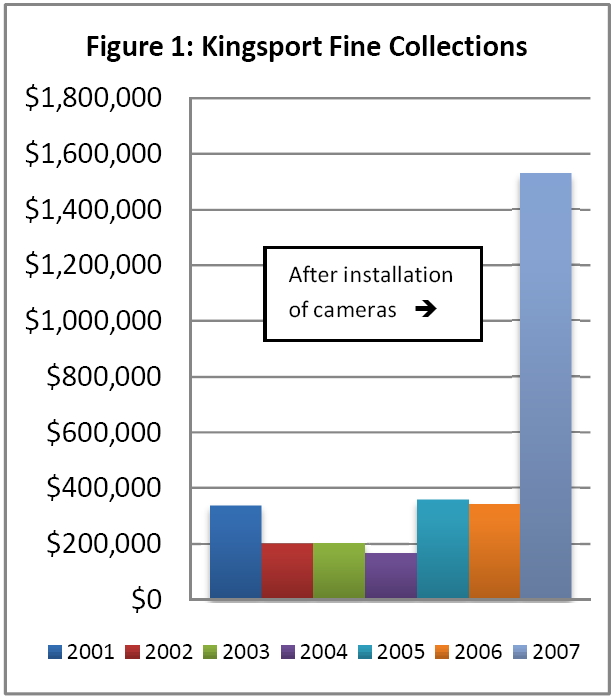 While cities claim that safety, deterrence, and cost-reduction are their ultimate priorities in camera system installations, revenue statements indicate otherwise. Cities that employ the devices see a dramatic spike in revenue for traffic violations. Revenues collected by the City of Kingsport during the 2006 calendar year, just before camera installation, totaled $342,150 for traffic fines, parking fines, and code enforcement fines.10 From 2001 to 2006, such fines ranged from $167,998 to $358,014 per year.11 Traffic cameras were installed on Dec. 27, 2006.12 Not surprisingly, fines skyrocketed. Kingsport collected $1,529,823 in the year after the cameras were installed, more than four times the revenue from the previous year (see “Figure 1: Kingsport Fine Collections,” right).13
While cities claim that safety, deterrence, and cost-reduction are their ultimate priorities in camera system installations, revenue statements indicate otherwise. Cities that employ the devices see a dramatic spike in revenue for traffic violations. Revenues collected by the City of Kingsport during the 2006 calendar year, just before camera installation, totaled $342,150 for traffic fines, parking fines, and code enforcement fines.10 From 2001 to 2006, such fines ranged from $167,998 to $358,014 per year.11 Traffic cameras were installed on Dec. 27, 2006.12 Not surprisingly, fines skyrocketed. Kingsport collected $1,529,823 in the year after the cameras were installed, more than four times the revenue from the previous year (see “Figure 1: Kingsport Fine Collections,” right).13
The most alarming aspect of this revenue generation is where the money goes. The camera companies enter into agreements with the cities, install the cameras, and sit back and let the cities do the dirty work. After collecting the fines from unsuspecting drivers, each city remits from 45 to 85 percent of the money to the companies. Thus, the cities’ actual revenue generated typically amounts to less than half that collected in fines (see “Figure 2: Fines Remitted by Municipalities to Camera Companies,” below).
The Problems: Collusion, Safety Decline, Constitutional Violations
Collusion
It is common for government to contract with private companies to provide services or goods to the public that the government ordinarily would supply. In fact, numerous private companies provide public services such as corrections facilities, fire and rescue service, and trash collection. Most often, privatized services are far more efficient and cost-effective than government could provide. According to a study conducted by the Reason Foundation, the federal government has saved taxpayers $7.2 billion over the past five years by privatizing services.14
However, when a private company obtains its entire profit from fines collected through traffic violation enforcement, many serious problems arise. Even more troubling is that, in certain cases, companies themselves are responsible for conducting police business. The agreement between the City of Germantown and Nestor provides that the company, not the city, is responsible for mailing citations and attempting to collect the fines.15
Since the contracts between the Tennessee cities and the camera companies stipulate that a large portion of the fines collected are to be remitted to the companies, the companies certainly have a strong interest to encourage a large number of fines. In many cases, the companies are reimbursed on a fine-by-fine basis. The cities pad their coffers with the remaining revenue generated by the systems. Hence, the two entities claiming to reduce the number of intersection accidents by deterring red light running have a vested interest in an increase in the number of drivers running red lights.
Simply put, increased obedience to traffic signals would significantly reduce revenues for both parties. If safety is truly the primary objective, these systems should eventually work themselves out of business, since red light running would end. Of course, that is not the goal of either the companies or the cities.
Unfortunately, the problem extends well beyond the local level. A May 2001 report by Dick Armey, then Majority Leader of the U.S. House of Representatives, concludes that citations generated by such cameras are a “federal issue and not just a local one.”16 The federal government is partially funding their implementation based on the purported “safety” benefits.17 Thus, not only are cities fining motorists to boost corporate revenues for companies based in other states and countries, but Congress is spending tax dollars to implement the systems.
Safety Decline
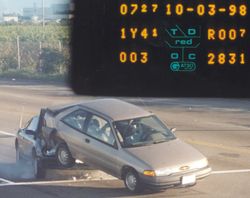 Numerous concerns also arise out of the traffic accidents associated with installing these camera systems. Various studies, including the Safety Evaluation of Red-Light Cameras, by the Federal Highway Administration, arrived at two conclusions: the devices reduce right-angle (Tbone) collisions, but increase rear-end collisions.18 Further, as one commentator suggests, the accuracy of statistical information disseminated by red light camera proponents is dubious. Engineer Dale Gedcke, PhD, noted in a report earlier this year that statistics related to red light cameras are problematic for two reasons. First, the “number of accidents reported before and after [red light camera] installation is so small that the statistical uncertainty in those numbers obscures any trend.” Second, “there are so many confounding variables [weather, day of the week, traffic flow, construction projects, etc.], that it is extremely difficult to extract the true effect of [red light cameras] without removing the effect of those confounding variables.”19
Numerous concerns also arise out of the traffic accidents associated with installing these camera systems. Various studies, including the Safety Evaluation of Red-Light Cameras, by the Federal Highway Administration, arrived at two conclusions: the devices reduce right-angle (Tbone) collisions, but increase rear-end collisions.18 Further, as one commentator suggests, the accuracy of statistical information disseminated by red light camera proponents is dubious. Engineer Dale Gedcke, PhD, noted in a report earlier this year that statistics related to red light cameras are problematic for two reasons. First, the “number of accidents reported before and after [red light camera] installation is so small that the statistical uncertainty in those numbers obscures any trend.” Second, “there are so many confounding variables [weather, day of the week, traffic flow, construction projects, etc.], that it is extremely difficult to extract the true effect of [red light cameras] without removing the effect of those confounding variables.”19
Keeping this statistical uncertainty in mind, data provided by Tennessee cities using red light cameras showed no significant overall decline in the number of accidents at camera-stationed intersections. Accidents reported by the City of Chattanooga declined at certain intersections, while increasing at others between January 2006 and May 2008.20
The Armey Report identifies a “Dilemma Zone” in which drivers cannot properly go or stop. It concludes that the zone, in concert with improperly adjusted yellow light duration times, is responsible for an increase in the numbers of accidents at intersections having red light cameras.
This makes sense. The yellow light exists to provide drivers time to make a decision. If they have enough time, drivers should come to a safe stop at the intersection. If not, drivers should have just enough time to continue through the intersection before the light turns red. Shortening the yellow light time forces drivers into even quicker decisions. Accordingly, the likelihood that drivers will make the wrong decision increases.
Interestingly, most controversy surrounding yellow light times coincides with the locations of intersections with red light cameras. Shortening yellow light duration to less than three seconds is a violation of Tennessee state law.21 Nonetheless, some Tennessee communities have tampered with the duration of yellow lights at intersections with cameras, creating inconsistency. In early 2008, Chattanooga was forced to refund $8,800 to defendants when the discrepancy was discovered.22
Nashville also is suspected of shortening yellow light duration. In 2006, Nashville resident Joe Savage clocked inconsistent durations of yellow lights in the Capital City.23 The Nashville Scene later confirmed his findings.24 Not surprisingly, Tennessee has plenty of company. Other communities around the country – including Springfield, Missouri; Lubbock and Dallas, Texas; and Union City, California – face similar charges.
Predictably, an increase in yellow light duration time by only one second has been shown to reduce accidents by up to 40 percent.25 In the city of Mesa, Arizona, a one-second increase in the duration of yellow lights yielded a 73 percent decrease in the number of citations issued by red light cameras.26 Other areas experienced similar declines in revenue through increasing yellow light duration times, including Fort Collins, Colorado, and the Commonwealth of Virginia, which experienced a 94 percent decrease of citations by increasing yellow light durations by 1.5 seconds.27 Virginia has since halted the use of red light cameras.
The mere presence of the watchful cameras encourages drivers to attempt to stop at yellow lights even if passing through the light would be safer. Coupled with a decrease in yellow light timing, this can readily explain the increase in the number of rear-end collisions that occur at intersections with red light cameras.
Unfortunately, most cities that use the cameras have failed to acknowledge the simple solution of yellow light timing, and as Dr. Gedcke suggests, those cities place enforcement over more practical engineering solutions. In fact, “when [cameras] show up as a proposal, engineering studies and solutions are almost never referenced,” notes Dr. Gedcke.28 His theory is that the cameras, primarily enforcement tools, are marketed directly to law enforcement officials, such as the city police chief. “Consequently,” states Gedcke, “the police department becomes the passionate advocate to the exclusion of the traffic engineering department.”29 As a result, city leaders place potential revenue over safety.
Constitutional Infringement
 Constitutional rights are infringed upon by the enforcement of the camera programs. The programs have faced numerous constitutional challenges. These challenges often fail on non-substantive grounds or are scoffed at by judges as titular and inconsequential, especially given the relatively small penalties involved.
Constitutional rights are infringed upon by the enforcement of the camera programs. The programs have faced numerous constitutional challenges. These challenges often fail on non-substantive grounds or are scoffed at by judges as titular and inconsequential, especially given the relatively small penalties involved.
A strong case can be made for constitutional violations on both procedural and substantive grounds. Procedural challenges range from evidentiary matters to sufficiency of notice. Substantive issues include the Confrontation Clause, self-incrimination, search and seizure, equal protection, and most significantly, due process, by shifting of the burden of proof to the defendant to prove non-guilt.
Gallatin’s program is now the subject of a lawsuit filed by Wayne Detring, an attorney from Hendersonville who received two such citations in the mail. As of this publication, however, it appears likely that the case will be dismissed as moot because the city voluntarily dismissed the citations, presumably in an attempt to avoid an unfavorable ruling on the A.C.E.S. program. Such actions make it all the more difficult to challenge the legality of the programs.
The number of successful challenges to the tickets proves this point. Of the 15,133 fines issues by Kingsport in 2007 and 2008, only nine defendants were found not guilty. That makes for a 99.9 percent guilty rate. The sheer unlikelihood of successfully challenging the fines contributes to the continuity of the programs.
Despite this hurdle, in March 2008, Judge Thomas Philips of the U.S. District Court for Eastern Tennessee sent a clear message regarding the constitutionality of these devices in Williams v. Redflex. In his order granting dismissal of the case on procedural grounds, Judge Philips stated, “Although this plaintiff lacks standing, the court is constrained to observe that the Red Light Photo Enforcement Program raises numerous constitutional questions.”30
Most communities have drafted civil, as opposed to criminal, statutes to prosecute these cases. Civil infractions are not reportable on driving records; hence, these communities count on Tennesseans not to challenge the system. Further, this linguistic maneuvering permits cities to skirt various constitutional protections afforded criminal defendants (including motorists cited for speeding violations) that are not invoked in civil cases. However, Tennessee case law negates this criminal versus civil distinction. Rather, the question turns not on the language used, but on whether the fine serves to remedy a violation (civil-like, and thus fewer constitutional implications) or whether it is punitive in nature (criminal-like, and thus invoking additional constitutional rights).31
Red light camera citations certainly fit within this criminal paradigm, because fining an individual who has already run a red light punishes that person for doing so, even if the end goal is to deter future running of red lights. Further, once the light has been run, the specific violation itself cannot be remedied. Contrast this from building and zoning violations, where civil fines properly entice violators to correct existing violations. This corroborates the notion that, although cities deem these fines to be civil, they are actually punitive, and additional constitutional protections should apply. Judge Philips made note of this Williams, stating that “[t]he key issue which must be resolved in these cases is whether the penalty imposed is civil or criminal. If the penalty is indeed criminal, then a panoply of federal constitutional rights, including rights to confrontation and rights against self-incrimination [will attach].”32
For tickets issued prior to July 1, 2008, a crucial issue is the lack of service of process. The Tennessee Rules of Civil Procedure require all complaints (including citations) be served upon defendants either personally or through certified or registered mail, return receipt requested. All cities in Tennessee that mail red light camera citations use regular mail to do so. This less protective process can lead to motorists being held liable for something they had no knowledge of whatsoever. It contravenes the entire notion of justice and fair play that serve as the basis for providing adequate notice to defendants in lawsuits.
The Tennessee General Assembly recently made it easier for municipalities to serve defendants with citations. As of July 1, 2008, cities operating camera programs no longer must comply with the Tennessee Rules of Civil Procedure regarding notice of service of process. Rather, they may send the citations via regular mail, without the protections the Rules are designed to afford.33 This codification of bad policy makes it all the more difficult for private citizens to challenge the actions of municipalities.
Another key issue is the lack of compliance with the Federal and Tennessee Rules of Evidence, which require a party offering photographic evidence into trial to authenticate the photograph. Those who have chosen to fight their red light camera citations in court have almost always found a very relaxed standard to meet these evidentiary requirements. In most instances, judges do not require the municipality to lay any evidentiary foundation before the photographs are admitted as conclusive evidence that the defendant is guilty of the violation. Such a lax attitude violates individuals’ rights, erodes the integrity of the judicial system, and could lead to egregious practices by city officials. In an extreme case, with photo-shopping techniques, it is not unforeseeable that city officials in custody of the photographs could use technology to their advantage to create the opportunity for more revenues. The rules of evidence are designed to protect against this possibility, and their abandonment or even relaxed enforcement increases the likelihood of abuse.
The most insidious issue arising from the application of these cameras is the unconstitutional shifting of the burden of proof to the defendant. A prevalent notion in the American criminal justice system is that defendants are innocent until proven guilty. Here, when defendants are presumed guilty until they prove otherwise, they have little chance of succeeding in court. This affront to both the United States and Tennessee constitutions makes challenging the legality of red light cameras all the more necessary, yet very difficult at the same time.
Conclusion
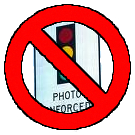 As the Armey Report notes, fixing the problems associated with these systems is more difficult because they generate millions of dollars in revenue. This conflict of interest creates no incentives for communities to solve the problem of red light running using other proven means, such as longer yellow light times.
As the Armey Report notes, fixing the problems associated with these systems is more difficult because they generate millions of dollars in revenue. This conflict of interest creates no incentives for communities to solve the problem of red light running using other proven means, such as longer yellow light times.
To achieve actual reductions in red light running and related accidents, Tennessee cities should look to states such as Texas and Virginia, where red light cameras are being disassembled, and yellow light durations extended. A simple one-second increase in yellow light duration has proven to be a far safer alternative to red light cameras. If cities really wish to increase the safety of their citizens, they should utilize this simpler and more cost-effective option.
Lawmakers must realize the importance of constitutional safeguards and critically reevaluate the supposed benefits of red light camera systems. If the General Assembly and municipal governments are serious about the safety of Tennesseans, they should work to guarantee safety, not reduce it. If our state’s legislative bodies continue to tread on citizens’ rights, then it becomes imperative that state and federal courts breathe life into the Constitution. A properly engaged judiciary is one that takes people’s rights seriously and bucks the trend of legislative deference. Government policy should never serve to the detriment of the citizenry just to make a quick buck.
About the Authors
George Shifflett is a research associate at the Tennessee Center for Policy Research. He can be reached at george at tennesseepolicy dot org.
Justin Owen, J.D., is the Director of Legal Policy at the Tennessee Center for Policy Research. He can be reached at justin at tennesseepolicy dot org.
About the Tennessee Center for Policy Research
 The Tennessee Center for Policy Research is an independent, nonprofit and nonpartisan research organization dedicated to providing concerned citizens, the media and public leaders with expert empirical research and timely free market policy solutions to public policy issues in Tennessee.
The Tennessee Center for Policy Research is an independent, nonprofit and nonpartisan research organization dedicated to providing concerned citizens, the media and public leaders with expert empirical research and timely free market policy solutions to public policy issues in Tennessee.
The Center generates and encourages public policy remedies grounded in the innovation of private enterprises, the ingenuity of individuals and the abilities of active communities to achieve a freer, more prosperous Tennessee.
Guarantee of Quality Scholarship
The Tennessee Center for Policy Research is committed to delivering the highest quality and most reliable research on Tennessee policy issues. The Center guarantees that all original factual data are true and correct and that information attributed to other sources is accurately represented. The Center encourages rigorous critique of its research. If an error ever exists in the accuracy of any material fact or reference to an independent source, please bring the mistake to the Center’s attention with supporting evidence. The Center will respond in writing and correct the mistake in an errata sheet accompanying all subsequent distribution of the publication, which constitutes the complete and final remedy under this guarantee.
Permission to reprint in whole or in part is hereby granted, provided that the Tennessee Center for Policy Research is properly cited.
Copyright © 2008 by The Tennessee Center for Policy Research,
Nashville, Tennessee
P.O. Box 121331
Nashville, Tennessee 37212
(615) 383-6431 · Fax: (615) 383-6432
http://www.tennesseepolicy.org · info@tennesseepolicy.org
References
- 1 “Communities using red light and/or speed cameras.” Insurance Institute for Highway Safety. 05 Aug. 2008.
- 2 Ibid.
- 3 “Red Light Camera Program.” City of Red Bank, Tennessee. 26 June 2008. ., “Open house held at GPD related the red light camera enforcement system.” Gallatin Police Department. 06 Sept. 2006. 26 June 2008.
- 4 “North American Presence.” Redflex Traffic Systems, Inc., North America. 26 June 2008.
- 5 Willard, Michelle. “Red-light cameras go online Sunday.” The Murfreesboro Post 27 May 2008.
- 6 Garlington, Lela. “Germantown will add third traffic-light camera.” Commercial Appeal 25 Oct. 2007.
- 7 Harris, Tom. “How Red-light Cameras Work.” HowStuffWorks.com. 15 April 2008.
- 8 Storment, Corporal W. “Gallatin Police Department Interview.” Telephone interview. 25 Apr. 2008. Interview conducted by George Shifflett.
- 9 “City of Jackson Notice of Violation.” City of Jackson Police Department. 17 May 2008.
- 10 “Records Division.” Kingsport Police Department. 7 Mar. 2008. 20 Apr. 2008.
- 11 Ibid.
- 12 Agreement between Redflex Traffic Systems, Inc. and Kingsport, Tennessee, ¶ 1.
- 13 Ibid.
- 14 Gilroy, Leonard C., ed. Annual Privatization Report. Rep. Reason Foundation. 2008. p 5.
- 15 Agreement between Nestor Traffic Systems, Inc. and Germantown, Tennessee, Exhibit A, Section 3.
- 16 Armey, Rep. Dick. “The Red Light Running Crisis: Is it Intentional?” Highway Robbery. May 2001. 10 June 2008.
- 17 Ibid.
- 18 Safety Evaluation of Red-Light Cameras. U.S. Department of Transportation. Federal Highway Administration. April 2005.
- 19 Gedcke, Dale. The Placebo Effect and Red-Light Cameras. 8 June 2008.
- 20 Data submitted by City of Chattanooga pursuant to open records request. Compiled by Ben Taylor, Traffic Engineering Department.
- 21 TENN. CODE ANN. § 55-8-110 (2008).
- 22 “Six Cities That Were Caught Shortening Yellow Light Times For Profit.” National Motorists Association. 26 Mar. 2008. 10 June 2008. light-times-for-profit/>.
- 23 Ibid.
- 24 Tobia, P.J. “Yellow Light Blues.” Nashville Scene 11 May 2006.
- 25 “Protest Red Light Cameras!” American Civil Liberties Union of Texas. 1 Nov. 2006. 15 June 2008.
- 26 Ibid.
- 27 Ibid.
- 28 Gedcke, Dale. Red Light Cameras (RLCs): Why Does Enforcement Trump Engineering? 22 June 2008.
- 29 Ibid.
- 30 Satterfield, Jamie. “Judge rejects red light lawsuit.” Knoxville News Sentinel 22 Mar. 2008.
- 31 City of Chattanooga v. Davis, 54 S.W.3d 248 (Tenn. 2001).
- 32 Satterfield, Jamie. “Judge rejects red light lawsuit.” Knoxville News Sentinel 22 Mar. 2008.
- 33 2008 Tenn. Pub. Acts 962.

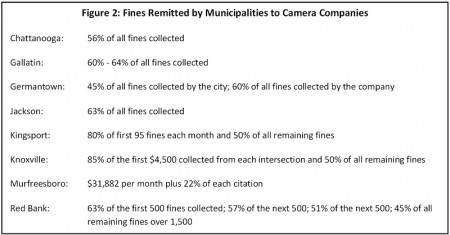


How do we get these cameras taken away? The courts are not on our side… they’re thinking of the Counties interests, most of the time. If they were not, how then would they allow the State Constitution to be usurped? Moving these cases to civil courts, also because the state of Tennessee’s constitution specifically says “No fine shall be laid on any citizen of this State that shall exceed fifty dollars, unless it shall be assessed by a jury of his peers, who shall assess the fine at the time they find the fact, if they think the fine should be more than fifty dollars. ” If they can’t get the fines up, they have to let civil court judges determine a “punitive” amount. Even judges are proving themselves to be crooked.
By the way… That was article VI section 14 on the fines
Lobbying, Referendums, political pressure, electing camera opponents, informing the public are all means of effecting change. Get involved and stay involved!
The issue is these fines are not ran through normal courts instead they use what’s known as an administrative law judge.